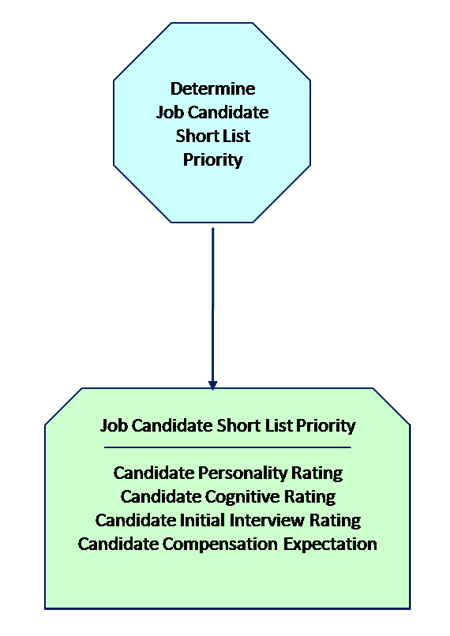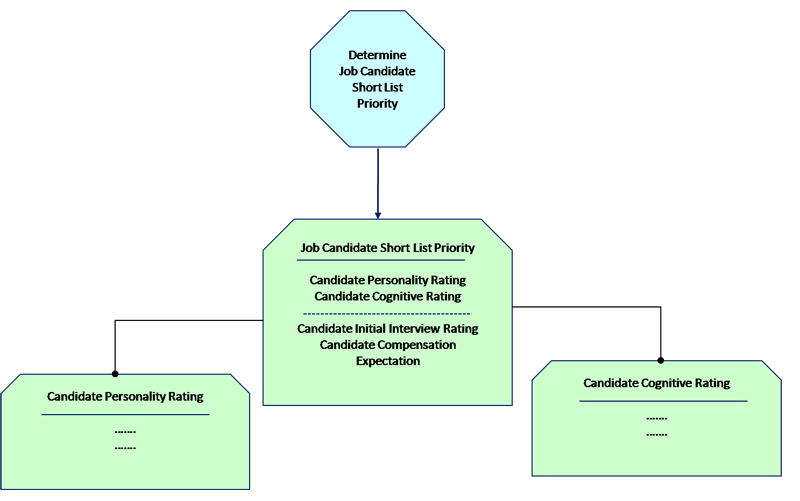(This article assumes knowledge of the Decision Model. If you are not already familiar with the theory of the Decision Model, you can download a brief primer from www.TheDecisionModel.com.)
Portions of this article are drawn from the book, The Decision Model: A Business Logic Framework Linking Business and Technology, von Halle & Goldberg, © 2009 Auerbach Publications/Taylor & Francis, LLC. This article consists, in part, of abstracts from the book; directly quoted passages, diagrams, and tables are cited, and are copyright © 2009 Auerbach Publications/Taylor & Francis LLC. Reprinted with the permission of the Publisher.
Most of us believe that business rules are important to the health of a business.We carry out some or all of the following:
However, it is time for an important question.
Are We There Yet?
Does the business perceive business rules as a true organizational asset? Are they visible, valuable, and universally accepted as data is? Above all, does business rule management attract and sustain enterprise-wide high-level management attention?
In truth, many organizations are not there yet. It helps to rethink it – take it up a notch. This article covers five reasons for doing so. We start with Reason #1, which encourages us to see the bigger picture.
Reason #1: Aim Higher
No matter how we write or store a business rule, most people treat it as a detailed requirement. Despite best intentions, often we capture business rules during design or implementation.
This is revealing if not backwards. We ask, “Is business rule management" the correct focus for defining a mature business rule management process? In other words, is the concept of a business rule at too low a level to justify a high-level business management process? The secret to quicker advances in maturity may be to elevate the management of business rules to the management of something of greater business magnitude and relevance – something executive management cares about, utilizes directly for business advantage, talks about, and which remains very tangible from inception to full development – the business decision, not the business rule.
The business decision is an orderly collection of business rules and business logic statements. More than that, the business decision is greater than the sum of its pieces. Practice proves that the business decision is the asset that the business really needs and wants to manage. Business rules are simply the details by which the business does so.” (von Halle and Goldberg, 2009)
Business decisions are an excellent starting point for precisely the right reason. Today, business people want (or need) to execute important business decisions properly. By presenting a business decision simply as a collection of business rules, business rules emerge anew – still as details but behind something bigger and of higher business value.
This thinking is gaining momentum. Tom Davenport (“Make Better Decisions,” Harvard Business Review, Nov 2009) states, “In recent years decision makers in both the public and private sectors have made an astounding number of poor calls.” He references Tenneco, General Motors, Time Warner, and Yahoo. “Decisions have been viewed as the prerogative of … senior executives…..The decision process, information, and logic are like a black box."
Davenport goes on to say that, today, decision-making is becoming the focus of systematic analysis. That sounds like businesses are recognizing the importance of decision-making and are taking steps to make it tangible. He explains success stories related to Chevron, Educational Testing service, and The Stanley Works. Larry and I consider all decisions, automated or not, as candidates for such focus, driven by their business impact.
So this is why Reason #1 advocates business decisions first, rules second. To get there, Reason #2 reveals that each business decision is driven by a (new kind of) model into which we put the business rules.
 Reason #2: Deliver Models, Not Lists
Reason #2: Deliver Models, Not Lists
Despite improvements in business requirements over the years , we don’t have a universal way to organize business rules that is technology independent, separated from other concerns, yet easily understood by business and technology audiences.
This is the role of a model, unique for business rules, with a structure as elegant, as simple, as the Relational Model is for data. It organizes them, based on the inherent structure of logic itself, into normalized structures that make sense to business people.
“So, the business decision and the idea that it can be modeled for business consumption elevate the business rule management process to that of business decision management. From an organizational maturity perspective, this shift upwards can have a profound effect. “(von Halle and Goldberg, 2009)
Next, Reason #3 addresses how to create such models iteratively, quickly, proving business value early.
Reason #3: Deliver Faster (Enable Business Innovation)
Capturing individual business rules is time-consuming. A full catalog or repository of business rules requires us to capture, analyze, and gain approval for them. As a bottom-up approach, this can seem to slow down a worthwhile project.
However, we can deliver a model top-down, getting to the finish line much faster. We can deliver iterative skeletal models even before we know any business rules! Doing so illustrates value early in a project and starts important business conversations. Iterative models put business leaders in charge of developing the models further. Sometimes the models unfold quickly by themselves. Other times, they require more time and spark business innovation. Funny, but no one seems to complain about time when it leads to game-changing innovation.
“Business people easily recognize that business value is not found in the individual business rule or business logic statement, but in entire business decisions. Therefore, entire Decision Models (even without details) emerge as the asset that drives toward business objectives.” (von Halle and Goldberg, 2009)
An example helps. Human Resource representatives are concerned about hiring employees. The process involves reviewing resumes, doing web research, conducting interviews, and prioritizing a short list of candidates. They desire a more consistent evaluation of candidates and automated support. They call this business decision “Determine Candidate Short List Priority.” Initial discussions uncover only four fact types (i.e., criteria) to use in the determination: Candidate Personality Rating, Candidate Cognitive Rating, Candidate Initial Interview Rating, and Candidate Compensation Expectation.
In the spirit of quick deliverables, they produce the skeletal model in Figure 1. The octagon represents the entire business decision. The ticket-shape at the end of the arrow is a Decision Rule Family, which produces a value for the business decision. Therefore, its name, at the top of the shape, is the name of the conclusion, Job Candidate Short List Priority. The four criteria appear below the solid line. There is more to know, but this instigates conversations.

Figure 1: First iteration Skeletal Model
In these conversations, we learn that an interviewer provides values for two criteria, Candidate Initial Interview Rating and Candidate Compensation Expectation. So, we put these below the dotted line as shown in Figure 2 because they are persistent data. Since business rules determine the values for the other criteria, we put these below the solid line, above the dotted line, and add a Rule Family for each. Eventually, we populate the business rules in all Rule Families, but not now. Figure 2 prompts new conversations about additional criteria, available data, and ideas about the future.

Figure 2: Second Iteration Skeletal model
Eventually, Figure 3 emerges with a complete set of Rule Families, relationships, and criteria. At this point, we may know only some business rules, not necessarily all, but this is still sufficient. Incremental delivery often leads to better quality business rules not to mention visions for different futures.

Figure 3: Third Iteration Skeletal Model
When we populate all Rule Families with business rules, we have Figure 4.

Figure 4: Finally, the Business Rules (click to enlarge)
Now that Reason #3 results in earlier deliverables and active business participation, Reason #4 delivers agility.
Reason #4: Affect Business Performance
The best way to attract high-level management is to deliver tangible business value.
We can do this with business decisions. Consider the business decision to “Determine a Customer’s Likelihood of Defaulting on a Loan”. A financial institution wants to reduce the number of defaulted loans by a certain percentage over a particular timeframe. Business rules behind this decision should aim for that reduction. We monitor actual loan defaults and tune the Decision Model as needed.
In practice, we correlate specific metrics to an entire Decision Model to justify its development as well as monitor its performance. Metrics measure revenue, profit, customer satisfaction or size of work queues, for example. From these, business experts assess whether the Decision Model is performing as expected. If not, we make changes and put new business logic into play.
Onto Reason #5 which uncovers new horizons in business rule management.
Reason #5: Seek New Horizons for Business Rules
The transition from rules to decision management is usually a smooth one, with an added bonus. We often discover better solutions to common business rule challenges. An example is the evolution of the Decision Model to include views ("Evolving the Decision Model With Views"). Decision Model views are an elegant way to accommodate business rule variations in business rules for geographical regions or customers. For example, we could have different views of Figure 4 for specific job descriptions or special subsets of candidates.
Another area for improvement is in decision-aware business process modeling as discussed by Bruce Silver (http://www.brsilver.com/wordpress/2010/01/05/integrating-process-and-rules-part-2/#more-677). In this case, Figure 4 can be partly or wholly automated, or chopped into several automated services.
Summary
Should we ditch business rules? Quite the contrary! But we should give them a business boost (and vice versa!) We should recast them as part of something bigger – as the core of important manageable business decisions. Such decisions are everywhere. Armed with a model, business objectives, and iterative business-driven deliverables, we can use business rules to make a difference.
To get started, begin with a business decision and let it grow naturally into its business rules. This journey delivers tangible business value because we plan it that way.
Author: Barbara von Halle and Larry Goldberg of Knowledge Partners International, LLC (KPI)
 Larry Goldberg is Managing Partner of Knowledge Partners International, LLC (KPI), has over thirty years of experience in building technology based companies on three continents, and in which the focus was rules-based technologies and applications. Commercial applications in which he played a primary architectural role include such diverse domains as healthcare, supply chain, and property & casualty insurance.
Larry Goldberg is Managing Partner of Knowledge Partners International, LLC (KPI), has over thirty years of experience in building technology based companies on three continents, and in which the focus was rules-based technologies and applications. Commercial applications in which he played a primary architectural role include such diverse domains as healthcare, supply chain, and property & casualty insurance.
 Barbara von Halle is Managing Partner of Knowledge Partners International, LLC (KPI). She is co-inventor of the Decision Model and co-author of The Decision Model: A Business Logic Framework Linking Business and Technology published by Auerbach Publications/Taylor and Francis LLC 2009.
Barbara von Halle is Managing Partner of Knowledge Partners International, LLC (KPI). She is co-inventor of the Decision Model and co-author of The Decision Model: A Business Logic Framework Linking Business and Technology published by Auerbach Publications/Taylor and Francis LLC 2009.
Larry and Barb can be found at www.TheDecisionModel.com